The sight of cucumbers turning yellow can be somewhat of a puzzle. Is it normal or not?
Well, there are various causes of yellowing cucumbers. From overripening to pests to diseases to genetics, we’re here to discover why this happens and how to fix each cause.
Let’s begin!
Why is my cucumber turning yellow?
Overripe Cucumbers
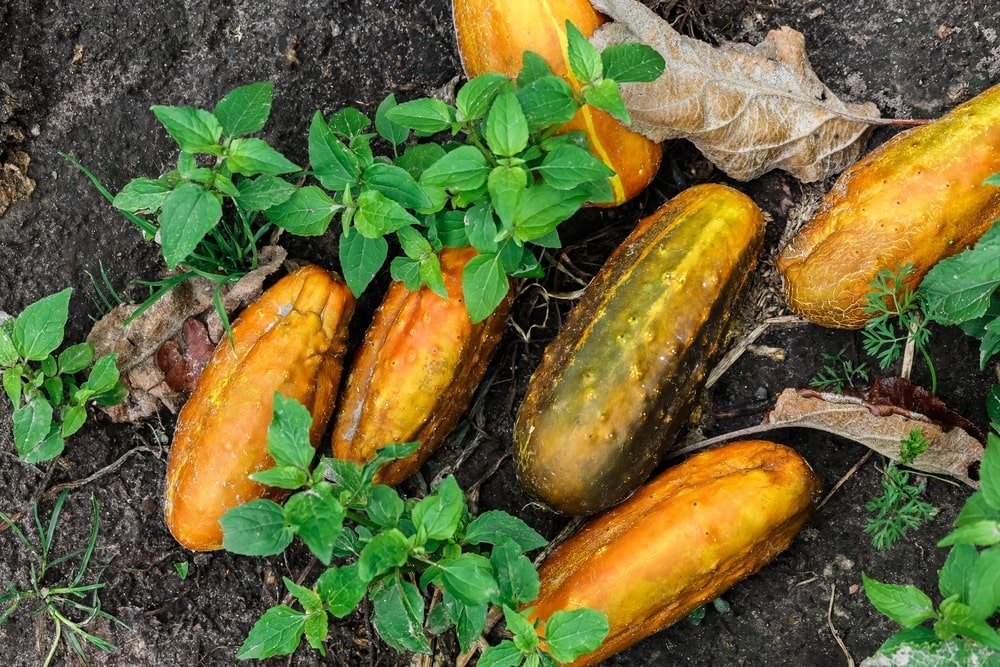
How to Fix: Harvest cucumbers at the recommended stage of maturity.
If you left your cucumbers on the vine for too long, chances are they’re going to ripen and turn yellow eventually. This is because they’ve gone beyond the ideal harvesting time.
The yellow color indicates the cucumber’s accumulation of seeds and changes in its composition. This color change affects the cucumber’s taste, texture, and overall quality, causing it to become bitter and less ideal for eating.
Solution: Harvest cucumbers at the recommended stage of maturity.
| Factor | Information |
| Difficulty | Low ●○○○○ |
| Speed | Quick |
| Materials Needed | Pruning shears or knife |
It’s all about harvesting your cucumbers once they’ve reached the mature stage. Harvesting is pretty easy as long as you do it properly without damaging the plant.
You’ll need to make sure you have sharp and clean pruning shears or a knife, preferably sterilized. Check your plant for mature cucumbers, which should be firm with a vibrant green color or as according to its variety.
Cut the stem of the cucumber cleanly with a sharp knife. If you have a lot of cucumbers to harvest, bringing a basket along would make things easier for you.
Nutrient Deficiencies
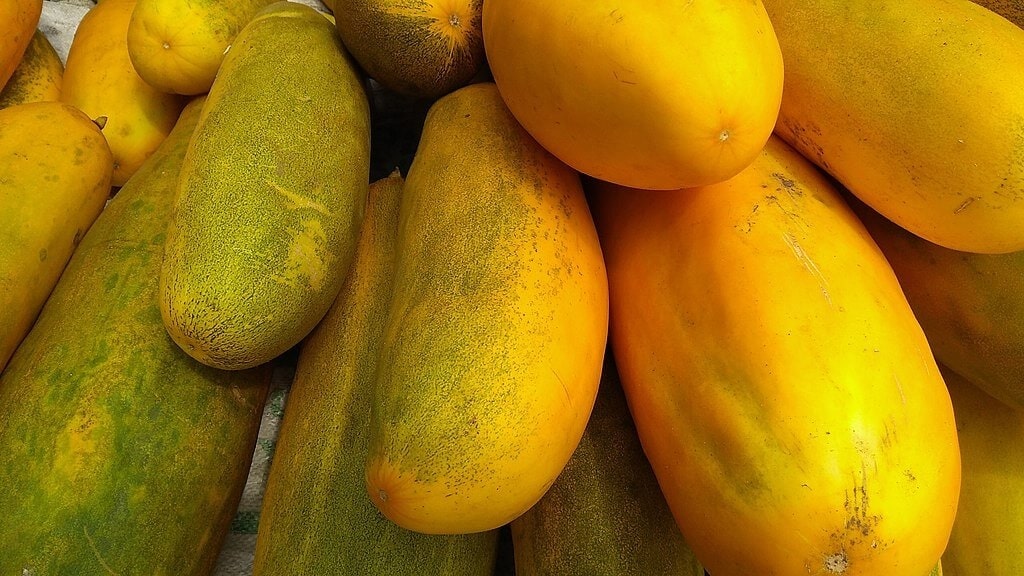
How to Fix: Provide the lacking elements through fertilization or soil amendments.
When the cucumber vine isn’t getting enough nutrients, it can lead to yellowing leaves and even the fruit itself. Yes, cucumbers are botanically considered fruits since they have seeds in the middle parts and they develop from the flower of the plant.
Now, going back to nutrient deficiencies, the yellowing is most likely due to nitrogen, potassium, or magnesium imbalance. These deficiencies cause the cucumber vine to be unable to photosynthesize – causing irregularities in growth and development.
Solution: Provide the lacking elements through fertilization or soil amendments.
| Factor | Information |
| Difficulty | Moderate ●●○○○ |
| Speed | Gradual |
| Materials Needed | Balanced fertilizer, compost, soil test kit |
There are two ways to go about fixing the nutrient deficiencies: fertilizers or compost. Either way, you’ll still need a soil test kit to find out what nutrients are deficient and which ones are balanced or are in abundance.
The soil test kit can be purchased from garden centers as well as through online vendors. However, those offered by laboratories are more accurate and have more information than the commercial ones.
Once you’ve figured out the deficiencies, you can use fertilizers or compost to enrich the soil and balance out the nutrients. Fertilizers can be quick-release or slow-release while compost is more of a slow-release soil amendment.
Water Stress
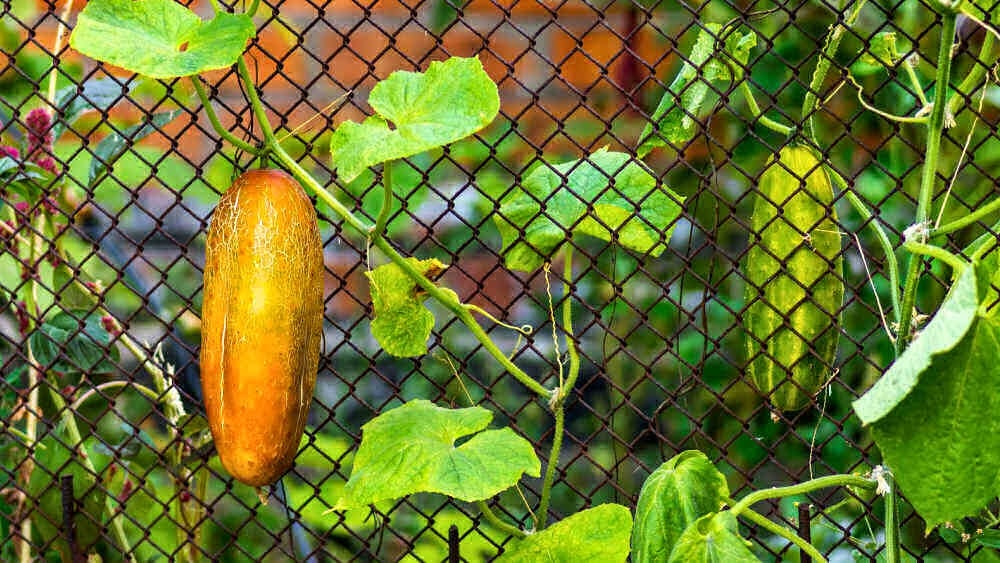
How to Fix: Maintain consistent and adequate moisture levels in the soil.
Just like humans can get stressed from too much or too little water, cucumber plants can also experience this condition. The result? Yellowing leaves, reduced fruit production, and even unusual yellowing of the fruits.
This is especially true when the cucumber plant is underwatered. The lack of water affects the plant’s ability to take in nutrients, resulting in yellowing fruit development.
Solution: Maintain consistent and adequate moisture levels in the soil.
| Factor | Information |
| Difficulty | Low to Moderate ●●○○○ |
| Speed | Quick to Gradual |
| Materials Needed | Watering can, drip irrigation system, mulch, water moisture meter (optional) |
The great thing about fixing watering stress is that it’s pretty simple – just provide the right amount of water for the plant. You can do that by using a watering can or a drip irrigation system and topping the soil with mulch to help retain the moisture.
While the watering can is more straightforward, the drip irrigation system provides a more streamlined approach to getting the soil moisture right. The downside is that you’ll have to spend a bit for this convenience.
If you’re still unsure about getting the drip irrigation system, you can always get the water moisture meter. It will help you identify when the soil needs to be watered, even if it’s done manually.
Plant Diseases
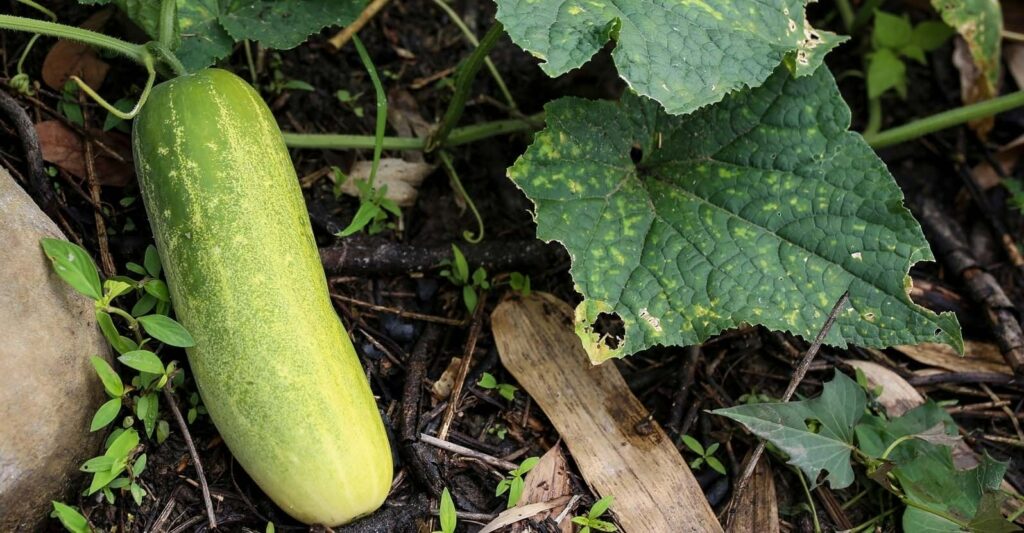
How to Fix: Preventive measures, including proper sanitation and, if needed, the use of fungicides or other targeted treatments.
Fungal infections, bacterial wilt, or viral diseases are the culprits of yellowing cucumbers. Fungal infections include powdery mildew, downy mildew, and anthracnose that can interfere with the plant’s ability to photosynthesize.
Cucumber bacterial wilt is caused by the bacterium Erwinia tracheiphila, transmitted by cucumber beetles, which makes the plant go yellow.
Cucumber mosaic virus (CMV) and cucumber green mottle mosaic virus (CGMMV) are common culprits to yellowing fruits too. Bacterial diseases like bacterial leaf spot and bacterial soft rot also impact cucumbers, leading to yellowing fruits.
Solution: Preventive measures, including proper sanitation and, if needed, the use of fungicides or other targeted treatments.
| Factor | Information |
| Difficulty | Moderate to High ●●●●○ |
| Speed | Gradual to Variable |
| Materials Needed | Fungicides, copper-based sprays, pruning tools |
If your cucumber already has one of these diseases, the best you can do is treat it with the right plant solutions. Fungicides or copper-based sprays are great at treating and preventing diseases from spreading.
Simply follow your preferred treatment solution’s instructions to make sure everything is safe. Usually, you’ll first prune the affected leaves or plant parts and then apply the treatment solutions.
Just know that most diseases usually are hard to treat, so it’s better to prevent them rather than to treat them. Best prevention methods include practicing good garden hygiene by removing and disposing of diseased plant parts and sterilizing tools.
Lack of Pollination

How to Fix: Create a conducive environment for pollinators or use hand pollination techniques.
Without any pollinators, cucumbers can go yellow. This is because the act of pollination fertilizes the ovaries of the cucumber flowers.
When this doesn’t happen, it can lead to incomplete fruit formation. When the fruit isn’t formed properly, it can lead to all sorts of complications, including yellowing cucumber fruits.
Solution: Create a conducive environment for pollinators or use hand pollination techniques.
| Factor | Information |
| Difficulty | Low to Moderate ●●○○○ |
| Speed | Variable |
| Materials Needed | Pollinator-friendly plants, hand pollination tools |
You have 2 choices when it comes to pollinating your cucumbers. You can either encourage pollinators to do the work, or you can do the pollination yourself.
If you’re going for the former, it’s best to plant pollinator-friendly flowers nearby to invite bees, butterflies, birds, and other pollinators to take a garden visit to your plants. At the top of our heads, we suggest lavender, borage, zinnia, sunflower, and cosmos.
If you’re going to hand-pollinate the cucumber plant, then you can use a small brush or cotton swab. While it can require some effort, hand-pollination ensures a better fruit set and lowers the chances of cucumber yellowing due to incomplete pollination.
Pest Issues

How to Fix: Encouraging natural predators, using insecticidal soaps, and implementing preventive measures.
Pests such as aphids, mites, and cucumber beetles are just some of the most common unwanted insects that feed on cucumber plants. These insects feed on the leaves, stems, and fruits of the plant, causing them to yellow.
Plus, these pests can also be carriers of diseases, which can worsen the plight of the cucumber plants. Pests plus diseases they carry can quickly make the cucumber plant sickly, resulting in yellowing leaves and fruits.
Solution: Encouraging natural predators, using insecticidal soaps, and implementing preventive measures.
| Factor | Information |
| Difficulty | Moderate ●●○○○ |
| Speed | Gradual |
| Materials Needed | Insecticidal soaps, beneficial insects, row covers |
While pests are troublesome visitors, they can be eliminated by using one or a combination of approaches. Insecticidal soaps are relatively quick fixes while the introduction of beneficial insects to the garden offers a longer-term solution.
Using row covers is a great preventative measure as it keeps pests away although it does keep pollinators at bay too. Whichever method you prefer, make sure it suits your needs so that you’ll end up with healthy, delicious, and nutritious cucumbers.
Lack of Sunlight
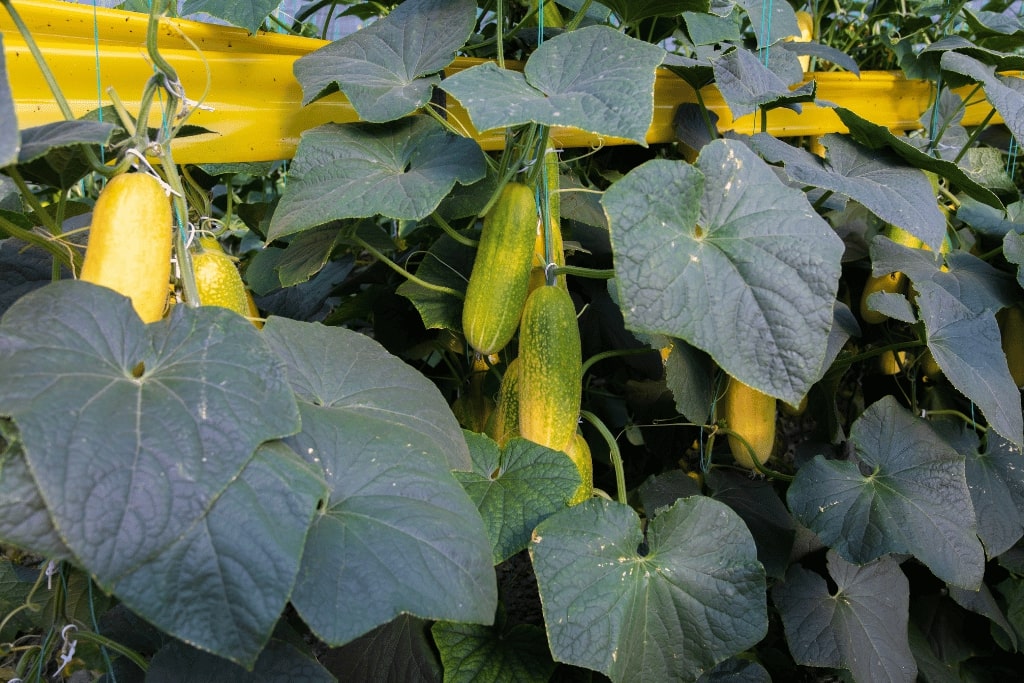
How to Fix: Adjust planting locations or improve light exposure.
Most plants need sunlight to grow healthy and strong, and the cucumber is no exception. When sunlight is lacking, the cucumber is unable to photosynthesize properly, leading to yellowing leaves and fruits.
The lack of sunlight can be caused by various factors such as shading from nearby plants, overcrowding, or planting in an area with limited sun exposure. If this is your possible reason for yellowing cucumbers, then you can still do something about it.
Solution: Adjust planting locations or improve light exposure.
| Factor | Information |
| Difficulty | Low to Moderate ●●○○○ |
| Speed | Gradual |
| Materials Needed | Pruning tools, adjusting planting locations |
Now, if the cause of your yellowing cucumbers is too much shade from other plants, the solution is simple: prune them. Use a clean and sterilized pair of pruners to get rid of the leaves of the plants that have been keeping the cucumbers in the shade.
But if possible, transplant the cucumber plants to a sunnier spot with more direct light – around 6 to 8 hours. This solution is better as it’s geared toward a longer-term fix rather than a quick one with recurring follow-ups.
Pick whichever method suits you best. Both can help prevent yellowing cucumber fruits by providing enough sunlight and airflow to your plants.
Temperature Extremes
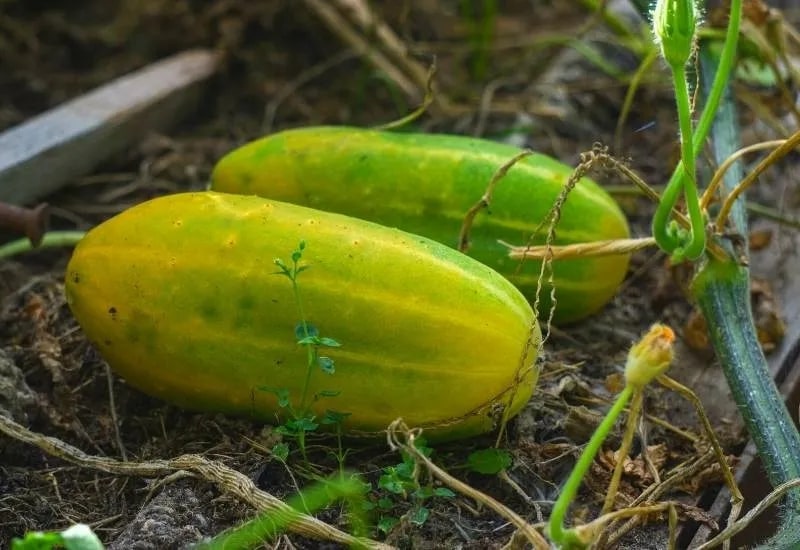
How to Fix: Provide shade during hot spells and use protective coverings during cold periods.
Whether it’s the scorching heat or the chilling cold, temperature extremes are never kind to cucumbers. In high temperatures, cucumber plants can get heat stress that disrupts nutrient absorption – causing yellow cucumbers.
When it’s cold, the cucumber plant can also experience damage to its sensitive plant tissues. Unable to provide enough nutrients, the plant can end up with yellowing cucumbers.
Solution: Provide shade during hot spells and use protective coverings during cold periods.
| Factor | Information |
| Difficulty | Low to Moderate ●●○○○ |
| Speed | Variable |
| Materials Needed | Shade cloth, protective coverings, mulch, greenhouse (optional) |
When your area experiences hot summers, get your shade cloth ready to protect your cucumber plants from the heat. The same goes if your area has cold spells – make sure you have protective coverings like row covers to shield them from frost.
Applying mulch around the base of your cucumber plants helps since it regulates soil temperature and maintains a more stable growing environment. Another option is to plant them under controlled environments like those in a greenhouse.
Genetics and Variety
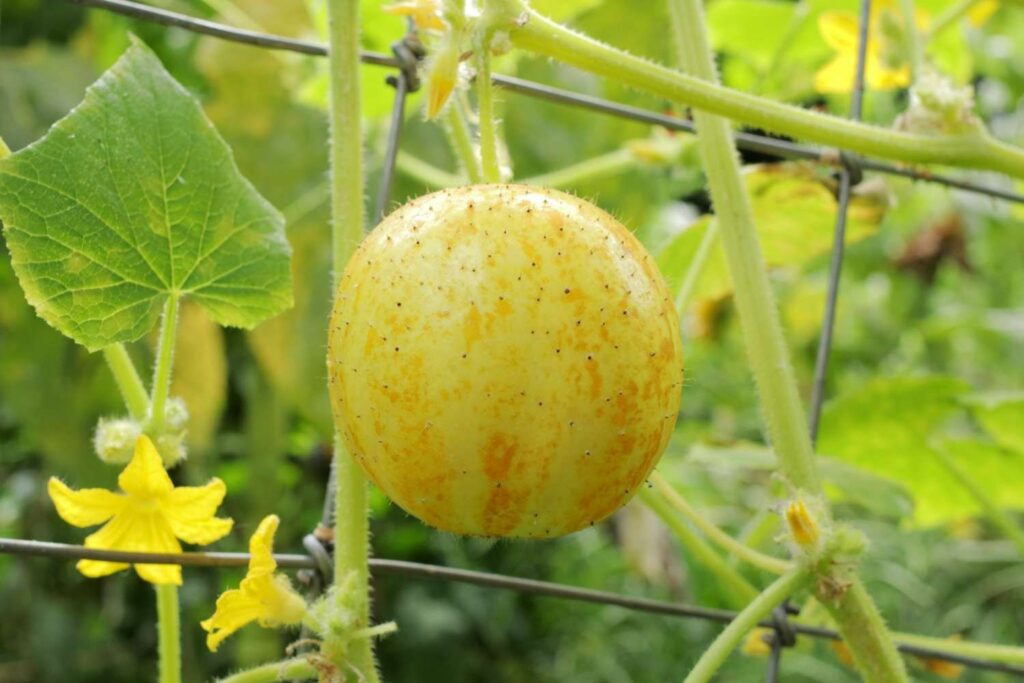
How to Fix: None – simply enjoy your yellow cucumbers when they reach maturity.
Some cucumber varieties such as ‘Lemon’, ‘Boothby’s Blonde’, and ‘Silver Slicers’ are bred to become yellow even before they mature. Unlike the typical green cucumbers, these varieties are specifically grown for their unique appearance and distinct flavor.
The inherent yellow color is a defining characteristic rather than an indication of any underlying issues. If you have unknowingly grown yellow cucumber varieties in your garden, then there’s no need to worry.
Solution: None – simply enjoy your yellow cucumbers when they reach maturity.
| Factor | Information |
| Difficulty | Not applicable |
| Speed | Not applicable |
| Materials Needed | Not applicable |
Growing a yellow cucumber variety is a deliberate choice, and the yellow color is a natural part of their development. There’s no corrective measures needed – just make sure that you harvest them as they mature.
Once harvested, you can enjoy these perfectly ripe yellow cucumbers in salads, smoothies, and other dishes.
Can you eat cucumbers that turn yellow?
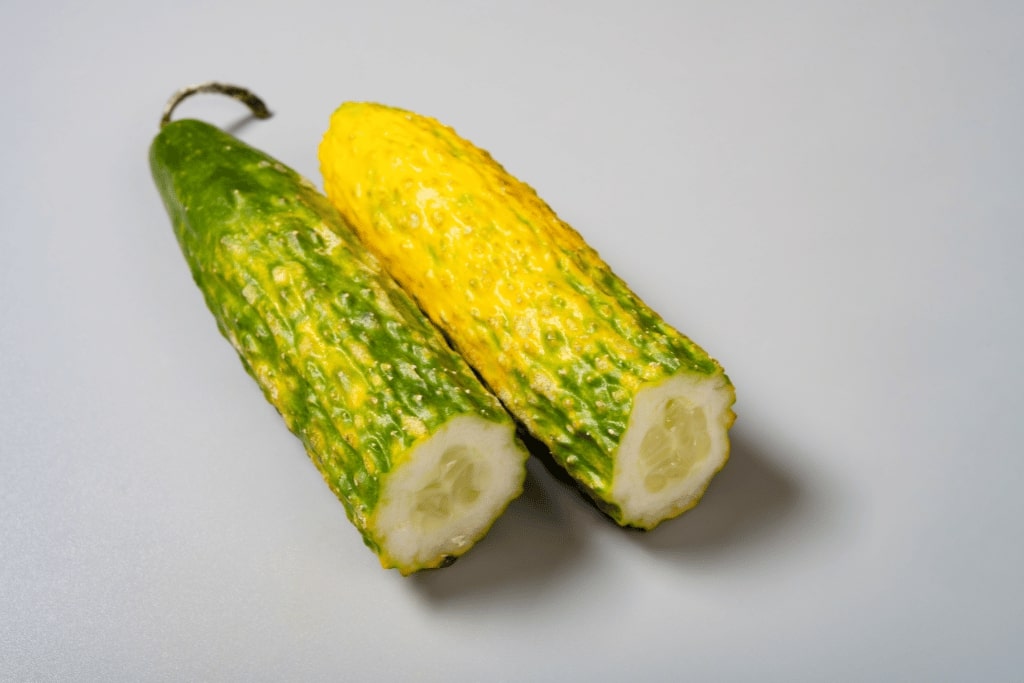
You can eat cucumbers that turn yellow, as their yellow color may indicate natural ripening rather than spoilage. The change in color is common as cucumbers mature, and some varieties are naturally yellow when fully ripe.
Just note that yellow cucumbers may have a different taste and texture compared to green ones. While it’s still safe, avoid eating those that have signs of rot or disease as they might not be safe for consumption.
Should I cut off yellow cucumber leaves?
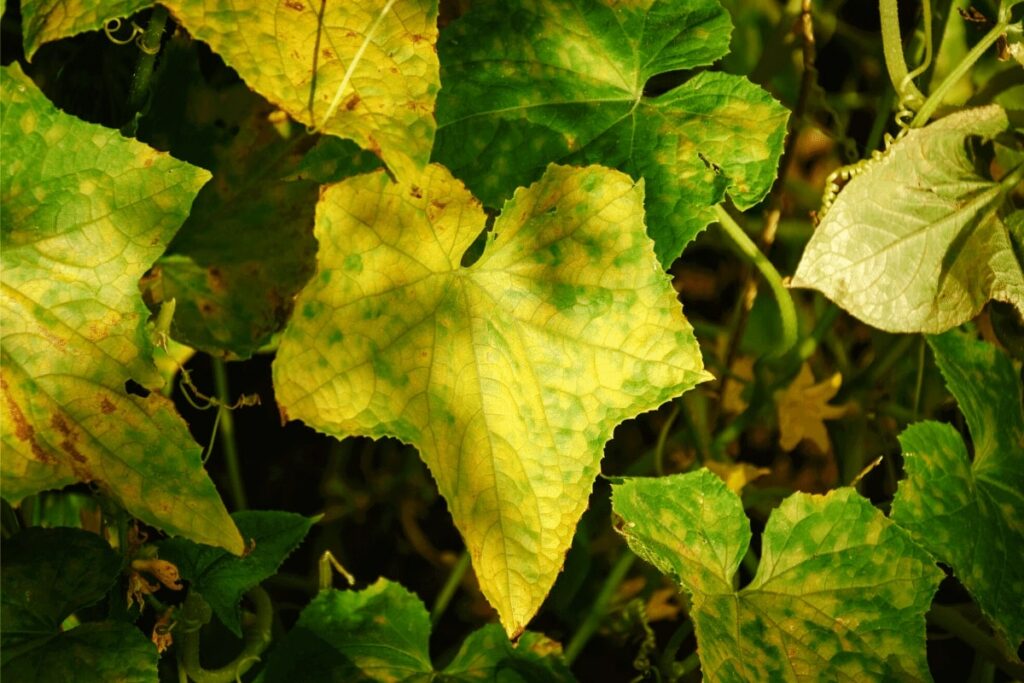
It’s generally best to cut off yellow cucumber leaves. Doing so helps to promote the overall health of the plant while preventing the spread of potential pests and diseases.
Plus, removing yellowing leaves encourages the cucumber plant to produce healthier green foliage while allowing more room for airflow. Make sure to use clean and sterilized tools in pruning cucumber leaves, and inspect for pests and diseases when doing so.





